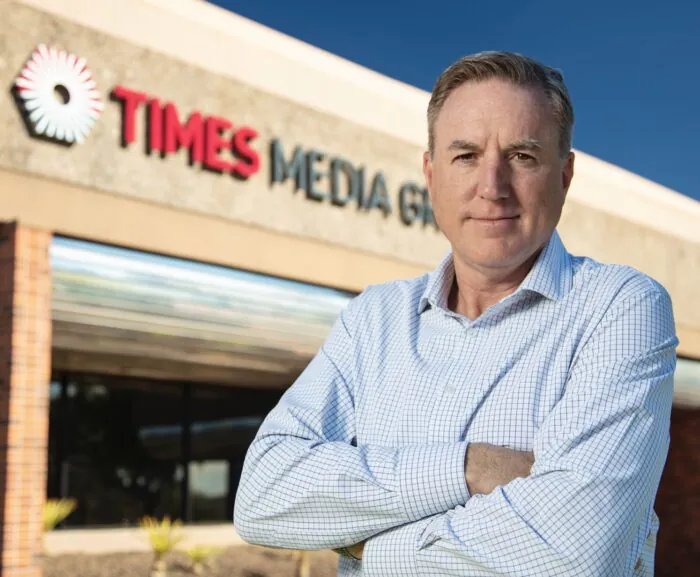Is any newspaper better than a news desert? Steve Strickbine thinks the answer to that question is yes.
I recently published a story, “National Trust for Local News sells 21 newspapers to a company with a history of gutting local news outlets.” Strickbine, founder and president of the Arizona-based group that acquired the local publications, didn’t respond to my request for comment before publication, but after the story came out, he got in touch. He didn’t challenge the pattern of cuts and reductions outlined in the piece, but didn’t like being associated with “gutting” and “devastating” local newsrooms.
Many of the local newspapers he acquired, he said, would have folded without his intervention.
It’s rare, in my experience, to hear directly from newspaper owners making cuts to local newsrooms. Hedge funds and private equity firms control more than half of the daily newspapers in the U.S. and owners like Alden Global Capital have hollowed-out local newsrooms for decades, almost never going on the record to talk about the cuts. When I asked Strickbine for an interview, however, he agreed to speak the next day.
Our back-and-forth over “gutted” is not just semantics. And it’s not only ego that makes Strickbine believe he’s the good guy in this story. What started as a single weekly newspaper in Scottsdale, Arizona has grown into a profitable network with more than 60 local newspapers. As I noted when first reviewing the Times Media Group acquisitions, nearly all of the distressed local news publications Strickbine has purchased remain open. It’s a notable accomplishment. After all, more than a third of local newspapers in the U.S. have closed in the last 20 years, including more than 100 in 2024.
Strickbine believes that local newspapers are worth saving, even if they’re no longer able to act as watchdogs or sustain a full newsroom. He is committed to a free, advertising-supported business model. You may not agree with Strickbine’s vision for local news. I do not. But I’ve never interviewed a newspaper owner so willing to defend his record and speak as plainly about what keeping the lights on actually looks like in many local communities.
Strickbine’s Times Media Group has a pattern. Soon after a paper is acquired, the masthead gets shorter — often much shorter. One former Times Media Group employee told me, “They devastated the newsrooms that I worked in, and I had to quit after a year because I couldn’t put out a product I could be proud of.” Another former employee told Phoenix Magazine,”When he acquired a news publication, most of the staff was fired [and replaced with cheaper talent].” Another journalist noted they’d “gutted” staff in California.
In an interview this month, soon after he’d acquired the 21 newspapers in Colorado, Strickbine defended the staff cuts as necessary to keep the papers alive. He stressed that he’s “not a hedge fund.”
“I don’t think I’m a traditional person in this business. I’m not just buying papers to cut newsrooms. I mean, if you knew me at all, you’d know that I absolutely feel like this is a worthy and important cause,” Strickbine told me. “Whenever we’ve had to make staff reductions, these are some pretty sad situations where the papers have been almost run in the ground and very likely would not exist had we not taken them over.”
The California-based Century Group Media, for example, had been losing $200,000 a year for multiple years before being acquired by Strickbine in 2024, he said. Soon after taking over the newspapers, Strickbine implemented what he calls “business discipline” — staff reductions and other cuts.
“I’m never sure whether these papers are going to make it,” Strickbine said. “I’m just trying my best to make it happen. That’s going to mean reductions, obviously.”
Measuring the shrinking of local news can be difficult. The news industry has invented a bunch of ghoulish terms — zombie publications, ghost newspapers, and news mirages — to refer to local outlets that continue to keep the lights on, put out a print product, and sell ads and subscriptions even as they fail to do much actual journalism. That’s why I always want to know the size of the newsroom. How many local journalists are on the ground? How many reporters are there to attend public meetings, read the fine print of the revised budget, and demand answers from elected officials? How many are driving the same roads, picking kids up at the same schools, seeing the same utility bill increases, and experiencing the same weather as the people reading the paper?
Times Media Group has about 60 full-time journalists, Strickbine said. It also paid 218 freelance contributors in March. With more than 60 newspapers in the group, that’s a little less than one full-time journalist per newspaper. The National Trust for Local News, which has struggled to reconcile its promises to save local newspapers with the on-the-ground realities, will have a similar ratio across its remaining newspapers in Colorado: seven reporters and one editor across seven newspapers.
Strickbine described a method of “platooning” across his local newspapers in which reporters from areas having “a slow news week” contribute coverage to other publications. There are also two executive editors who edit across dozens and dozens of outlets in Times Media Group — often from hundreds of miles away.
“It’s just kind of the way it is. Do we have the watchdog role? Can we do that now in all these areas? No. I think that’s obvious,” Strickbine said. “We have to just manage those resources well and really try to do our best.”
It’s a pragmatic approach that nevertheless leaves local communities in a strange limbo. The local newspaper still publishes with events and local happenings, but without a newsroom equipped to hold power accountable. If many of the community newspapers owned by Times Media Group aren’t able to fill that critical local watchdog role, what exactly is being preserved?
I asked Strickbine about the unbylined pieces I’d noticed on most of the homepages of the newspapers he owns. The unbylined pieces are typically reworked press releases, he said.
Strickbine also brought up the sponsored content that appears in his newspapers. He sees local businesses as a constituency alongside readers.
“Part of business discipline is also building packages and remaining of value to the communities we serve — to the business communities we serve,” Strickbine said. “That doesn’t mean going out and doing stories about them. It means giving them access to have a story on our website that we cordon off under, like, recommended reading.”
Strickbine is committed to publishing online without a paywall, he said. Although Times Media Group news sites include “support local journalism” donation buttons, he confirmed his business model is chiefly advertising.
Just 15% of Americans pay for local news. When Strickbine acquired Acorn Newspapers in 2023, he removed the paywall that was up across the five weekly newspapers even though it was bringing in a “fairly significant” amount of revenue, he said.
“I’m willing to say democratizing this — what we produce — is critically important to me,” Strickbine said. “When we wall that off and charge somebody $15 a month, we are walling it off from the 70% of the people in the community who don’t feel they need to pay for that, or they’re just not willing to. It’s not good for the paper [and] it’s not good for the businesses.”
At one point in our conversation, Strickbine pushed back on the way I’d characterized a group of newspapers in Tucson going from five full-time staffers to one person writing for seven publications. I asked him what journalism he was proud to have published in Tucson in the last year. He couldn’t name any particular pieces. “I don’t get to see all these papers,” he acknowledged.
Strickbine believes that these local publications would not exist without his cuts and ownership. His argument is that the stripped-down local outlets are better than nothing and critics pushing for fewer cuts are out of touch with the brutal reality of local news economics.
With the Colorado acquisiton, Times Media Group now owns local newspapers in three states and is profitable, even if Strickbine says he’s “not running off with big margins of money.” Strickbine was the one who reached out to the National Trust for Local News, he told me, to offer to buy the group of papers around Denver. He plans to acquire more distressed local newspapers in the future.
“I’ll tell you something about our company that I think you should know: I don’t feel like I’ve got this figured out,” Strickbine said. “I just think my heart’s in the right place.”
Cite this article
CLOSE
MLA
Scire, Sarah. “This owner thinks newspapers are better off diminished than dead.” Nieman Journalism Lab. Nieman Foundation for Journalism at Harvard, 28 May. 2025. Web. 2 Jul. 2025.
APA
Scire, S. (2025, May. 28). This owner thinks newspapers are better off diminished than dead. Nieman Journalism Lab. Retrieved July 2, 2025, from https://www.niemanlab.org/2025/05/this-owner-thinks-newspapers-are-better-off-diminished-than-dead/
Chicago
Scire, Sarah. “This owner thinks newspapers are better off diminished than dead.” Nieman Journalism Lab. Last modified May 28, 2025. Accessed July 2, 2025. https://www.niemanlab.org/2025/05/this-owner-thinks-newspapers-are-better-off-diminished-than-dead/.
Wikipedia
{{cite web
| url = https://www.niemanlab.org/2025/05/this-owner-thinks-newspapers-are-better-off-diminished-than-dead/
| title = This owner thinks newspapers are better off diminished than dead
| last = Scire
| first = Sarah
| work = [[Nieman Journalism Lab]]
| date = 28 May 2025
| accessdate = 2 July 2025
| ref = {{harvid|Scire|2025}}
}}
To promote and elevate the standards of journalism
Covering thought leadership in journalism
Pushing to the future of journalism
Exploring the art and craft of story
The Nieman Journalism Lab is a collaborative attempt to figure out how quality journalism can survive and thrive in the Internet age.
It’s a project of the Nieman Foundation for Journalism at Harvard University.






